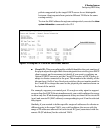
IP Routing Features
Configuring DHCP Relay
Operating Notes
■ This implementation of DHCP relay with Option 82 complies with the
following RFCs:
• RFC 2131
• RFC 3046
■ Moving a client to a different port allows the client to continue operating
as long as the port is a member of the same VLAN as the port through
which the client received its IP address. However, rebooting the client
after it moves to a different port can alter the IP addressing policy the
client receives if the DHCP server is configured to provide different
policies to clients accessing the network through different ports.
■ The IP address of the primary DHCP relay agent receiving a client request
packet is automatically added to the packet, and is identified as the giaddr
(gateway interface address). (That is, the giaddr is the IP address of the
VLAN on which the request packet was received from the client.) For
more information, refer to RFC 2131 and RFC 3046.
■ DHCP request packets from multiple DHCP clients on the same relay
agent port will be routed to the same DHCP server(s). Note that when
using 802.1X on a switch, a port's VLAN membership may be changed by
a RADIUS server responding to a client authentication request. In this case
the DHCP server(s) accessible from the port may change if the VLAN
assigned by the RADIUS server has different DHCP helper addresses than
the VLAN used by unauthenticated clients.
■ Where multiple DHCP servers are assigned to a VLAN, a DHCP client
request cannot be directed to a specific server. Thus, where a given VLAN
is configured for multiple DHCP servers, all of these servers should be
configured with the same IP addressing policy.
■ Where routing switch “A” is configured to insert its MAC address as the
Remote ID in the Option 82 fields appended to DHCP client requests, and
upstream DHCP servers use that MAC address as a policy boundary for
assigning an IP addressing policy, then replacing switch “A” makes it
necessary to reconfigure the upstream DHCP server(s) to recognize the
MAC address of the replacement switch. This does not apply in the case
where an upstream relay agent “B” is configured with option 82 replace,
which removes the Option 82 field originally inserted by switch “A”.
3-61


















